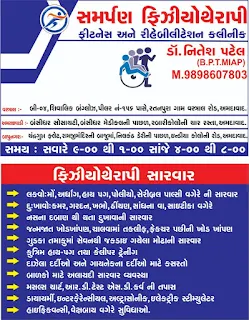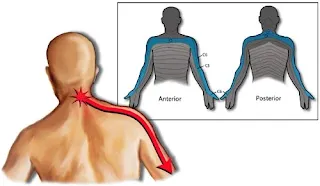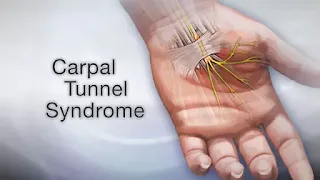What is a Cervical Radiculopathy?
Cervical radiculopathy refers to a condition where there is compression or irritation of one or more nerve roots in the cervical spine (neck region), leading to pain, numbness, or weakness in the areas of the body that the affected nerve supplies. The condition is often caused by degenerative changes in the spine, such as herniated discs, bone spurs, or narrowing of the spinal canal (stenosis). It can also be caused by trauma or injury to the neck, or by inflammation or infection in the area. Treatment options for cervical radiculopathy may include rest, physical therapy, medication, or in some cases, surgery.
Related Anatomy
The cervical spine, or neck region, consists of seven vertebrae, labeled C1 to C7, that are separated by intervertebral discs. Between each pair of vertebrae, a pair of nerve roots emerge from the spinal cord and exit the spine through small openings called foramina. These nerve roots then branch out to supply sensation and motor function to various parts of the body, such as the arms, shoulders, and hands.
The cervical spine also contains various ligaments, muscles, and other soft tissues that provide stability and support to the vertebrae and the surrounding structures. The ligaments help hold the vertebrae together, while the muscles allow for movement of the neck and head. The spinal cord, which is a long, thin bundle of nerve fibers that runs from the brain down through the spine, is protected by the vertebrae and surrounded by protective membranes called meninges.
Causes of Cervical Radiculopathy
Cervical radiculopathy can be caused by a variety of factors that put pressure on or irritate the nerve roots in the neck. Some common causes include:
- Herniated or bulging discs: When a disc in the cervical spine ruptures or bulges out of its normal position, it can press against the nerve root, leading to pain and other symptoms.
- Bone spurs: Bony growths that develop on the vertebrae due to age or degeneration can also impinge on the nerve roots, causing cervical radiculopathy.
- Degenerative disc disease: As the discs in the spine naturally age and wear down, they can lose height and become less flexible, leading to pressure on the nerve roots.
- Spinal stenosis: A narrowing of the spinal canal or foramina can occur due to conditions such as arthritis or degenerative disc disease, compressing the nerve roots.
- Trauma or injury: A sudden injury or trauma to the neck, such as a whiplash injury, can damage the nerve roots and cause symptoms.
- Infections or tumors: In rare cases, infections or tumors in the cervical spine can put pressure on the nerve roots and cause cervical radiculopathy.
- Poor posture: Prolonged sitting or standing in a slouched position or any position that places stress on the neck can cause or exacerbate cervical radiculopathy.
Symptoms of Cervical Radiculopathy
The symptoms of cervical radiculopathy can vary depending on the location and severity of the nerve root compression or irritation. Some common symptoms may include:
- Pain: Pain may be felt in the neck, shoulder, arm, or hand on the affected side. The pain may be sharp, burning, or dull, and may worsen with certain movements or positions.
- Numbness or tingling: Numbness or tingling may be felt in the same areas as the pain, and may be accompanied by a pins-and-needles sensation.
- Weakness: Weakness or difficulty with certain movements, such as lifting or gripping objects, may occur in the affected arm or hand.
- Loss of reflexes: Reflexes in the affected arm or hand may be reduced or absent.
- Headaches: Headaches may occur as a result of tension in the neck muscles or irritation of the nerves.
- Loss of coordination: In severe cases, cervical radiculopathy may cause loss of coordination or balance.
Symptoms may worsen over time if left untreated. It is important to seek medical attention if you experience any of these symptoms to determine the underlying cause and receive appropriate treatment.
Risk Factor
There are several risk factors that can increase the likelihood of developing cervical radiculopathy. Some common risk factors include:
- Age: As we age, the discs in our spine naturally lose moisture and become less flexible, making them more susceptible to damage or herniation.
- Occupation: Jobs that require repetitive neck or shoulder movements, such as those in construction, landscaping, or assembly line work, can increase the risk of cervical radiculopathy.
- Genetics: Some genetic factors can increase the risk of developing spinal conditions such as herniated discs or spinal stenosis, which can lead to cervical radiculopathy.
- Lifestyle: Poor posture, lack of exercise, and being overweight or obese can all contribute to degenerative changes in the spine that can lead to cervical radiculopathy.
- Previous neck injury: A history of neck injury or trauma, such as whiplash from a car accident, can increase the risk of cervical radiculopathy.
- Smoking: Smoking has been shown to increase the risk of developing spinal conditions that can lead to cervical radiculopathy.
- Certain medical conditions: Certain medical conditions such as arthritis, diabetes, and autoimmune disorders can increase the risk of developing cervical radiculopathy.
It is important to be aware of these risk factors and take steps to reduce your risk, such as maintaining good posture, exercising regularly, and seeking treatment for neck injuries or conditions as soon as possible.
Differential Diagnosis
The symptoms of cervical radiculopathy can overlap with other conditions, making it important to perform a differential diagnosis to rule out other potential causes of the symptoms. Some conditions that may be considered in the differential diagnosis of cervical radiculopathy include:
- Carpal tunnel syndrome: This condition occurs when the median nerve in the wrist is compressed, causing pain, numbness, and tingling in the hand and fingers.
- Thoracic outlet syndrome: This condition occurs when the nerves or blood vessels that pass through the thoracic outlet (the space between the collarbone and first rib) become compressed, causing pain, weakness, and numbness in the neck, shoulder, arm, and hand.
- Rotator cuff injury: Injury to the rotator cuff muscles or tendons in the shoulder can cause pain and weakness in the shoulder and upper arm.
- Brachial plexus injury: Injury to the brachial plexus (a network of nerves that controls movement and sensation in the shoulder, arm, and hand) can cause pain, weakness, and numbness in the arm and hand.
- Multiple sclerosis: This autoimmune disorder can cause a wide range of symptoms, including pain, numbness, tingling, and weakness in the arms and legs.
- Spinal cord compression: Compression of the spinal cord in the cervical spine can cause symptoms similar to cervical radiculopathy, but may also include difficulty with walking and bladder or bowel control.
- Fibromyalgia: This condition can cause widespread pain, fatigue, and other symptoms that may mimic cervical radiculopathy.
To arrive at a correct diagnosis, a healthcare provider will typically perform a physical examination, review medical history and symptoms, and may also order imaging tests such as X-rays, MRI, or CT scans.
Treatment of Cervical Radiculopathy
The treatment of cervical radiculopathy depends on the severity of the symptoms and the underlying cause of the condition. Some common treatments may include:
- Rest and activity modification: Resting the affected area and avoiding activities that aggravate symptoms can help reduce pain and inflammation.
- Physical therapy: A physical therapist can provide exercises and stretches to improve range of motion, strength, and flexibility in the neck, shoulder, and arm.
- Medications: Over-the-counter pain relievers such as ibuprofen or naproxen may help reduce pain and inflammation. In more severe cases, prescription medications such as muscle relaxants or nerve pain medications may be prescribed.
- Corticosteroid injections: Injections of corticosteroids into the affected area can help reduce inflammation and pain.
- Surgery: In cases where conservative treatments are not effective, surgery may be recommended to relieve pressure on the affected nerve root. The type of surgery performed will depend on the underlying cause of the cervical radiculopathy.
It is important to work with a healthcare provider to develop a treatment plan that is tailored to your individual needs and symptoms. In many cases, a combination of treatments may be used to provide the best possible outcome. Additionally, lifestyle changes such as maintaining good posture, exercising regularly, and avoiding smoking can also help prevent cervical radiculopathy and other spinal conditions.
Physical Therapy
Physical therapy can be an effective treatment for cervical radiculopathy. A physical therapist can work with you to develop a personalized treatment plan that may include exercises and stretches to improve range of motion, strength, and flexibility in the neck, shoulder, and arm.
Some common physical therapy techniques used for cervical radiculopathy include:
- Manual therapy: Hands-on techniques such as massage or joint mobilization may be used to relieve tension and improve range of motion in the affected area.
- Therapeutic exercises: Exercises that target the muscles in the neck, shoulder, and arm can help improve strength, flexibility, and posture. This can help reduce pressure on the affected nerve root and alleviate symptoms.
- Traction: Traction involves the use of a machine or harness to gently stretch the neck and relieve pressure on the affected nerve root.
- Electrical stimulation: Electrical stimulation may be used to help reduce pain and improve muscle function in the affected area.
- Postural education: A physical therapist can provide education on proper posture and body mechanics to help prevent further injury and improve symptoms.
Physical therapy may be recommended as a first-line treatment for cervical radiculopathy, especially for mild to moderate cases. However, it is important to work with a healthcare provider to determine if physical therapy is appropriate for your individual needs and symptoms.
Exercise for Cervical Radiculopathy
Exercise can be an effective treatment for cervical radiculopathy, but it is important to work with a healthcare provider or physical therapist to develop a safe and effective exercise program. Here are some exercises that may be helpful for cervical radiculopathy:
- Neck stretches: Slowly tilt your head to the right and hold for 10-15 seconds, then repeat on the left side. You can also tilt your head forward and backward to stretch the neck muscles.
- Shoulder rolls: Roll your shoulders forward and backward in a circular motion to loosen up the shoulder muscles.
- Scapular squeezes: Sit or stand with your arms at your sides and your shoulder blades pulled back and down. Hold for 5-10 seconds and release.
- Arm stretches: Reach one arm across your chest and hold for 10-15 seconds, then repeat with the other arm. You can also reach one arm overhead and use your other hand to gently pull it towards your head, holding for 10-15 seconds, then repeating on the other side.
- Wall angels: Stand with your back against a wall and slowly raise your arms up and down in a "W" shape. This exercise can help improve posture and strengthen the upper back muscles.
- Isometric exercises: Isometric exercises involve contracting the muscles without moving the joint. For example, you can place your hand against your forehead and gently push your head forward, using your neck muscles to resist the pressure.
It is important to start with gentle exercises and gradually increase intensity as your symptoms improve. Avoid any exercises that cause pain or discomfort, and be sure to rest if you experience any worsening of symptoms.
Ergonomics for Cervical Radiculopathy
Ergonomics, or the study of how people interact with their work environment, can play an important role in preventing and managing cervical radiculopathy. Here are some tips for improving ergonomics to reduce the risk of developing cervical radiculopathy or to manage symptoms if you already have the condition:
- Maintain good posture: Keep your head, neck, and shoulders in a neutral position while working at a desk or computer. Avoid slouching or leaning forward.
- Adjust your chair and desk: Make sure your chair and desk are at the proper height so that your feet are flat on the floor and your elbows are at a 90-degree angle when typing.
- Take breaks: Take regular breaks to stand up, stretch, and move around. This can help prevent muscle fatigue and reduce pressure on the neck and spine.
- Use proper lifting techniques: When lifting heavy objects, use your legs instead of your back and keep the object close to your body.
- Use a headset: If you frequently talk on the phone, consider using a headset to avoid cradling the phone between your ear and shoulder.
- Avoid repetitive motions: Avoid performing the same motion repeatedly for extended periods of time. Take breaks or switch tasks to prevent muscle fatigue.
- Use an ergonomic pillow: Use a supportive pillow that promotes proper neck alignment while sleeping.
By implementing these ergonomic strategies, you can help prevent or manage cervical radiculopathy symptoms and improve your overall spinal health.
How to Prevent Cervical Radiculopathy?
There are several ways to prevent cervical radiculopathy:
Practice good posture: Maintaining good posture while sitting or standing can help reduce the strain on your neck and prevent cervical radiculopathy.
Avoid repetitive motions: Avoid performing the same motion repeatedly for extended periods of time. Take breaks or switch tasks to prevent muscle fatigue.
Exercise regularly: Regular exercise can help improve flexibility, strength, and posture, which can reduce the risk of developing cervical radiculopathy.
Use proper lifting techniques: When lifting heavy objects, use your legs instead of your back and keep the object close to your body.
Use an ergonomic workspace: Ensure your workspace is set up ergonomically, with a chair and desk at the proper height, a supportive keyboard, and a monitor at eye level.
Wear protective gear: If you participate in sports or other activities that put you at risk for neck injuries, wear appropriate protective gear.
Manage stress: Stress can cause tension in the neck and shoulders, which can contribute to cervical radiculopathy. Practice stress-management techniques such as deep breathing, meditation, or yoga.
By following these preventative measures, you can reduce your risk of developing cervical radiculopathy and promote overall spinal health.
Summary
Cervical radiculopathy is a condition in which the nerve roots in the neck become compressed or irritated, causing pain, numbness, and weakness in the arms and hands. The condition can be caused by a variety of factors, including herniated discs, bone spurs, and degenerative disc disease. Treatment options include physical therapy, medication, and surgery. Exercise can also be an effective treatment for cervical radiculopathy.
Ergonomic strategies, such as maintaining good posture, using proper lifting techniques, and using an ergonomic workspace, can help prevent cervical radiculopathy. Regular exercise and stress-management techniques can also reduce the risk of developing the condition.


